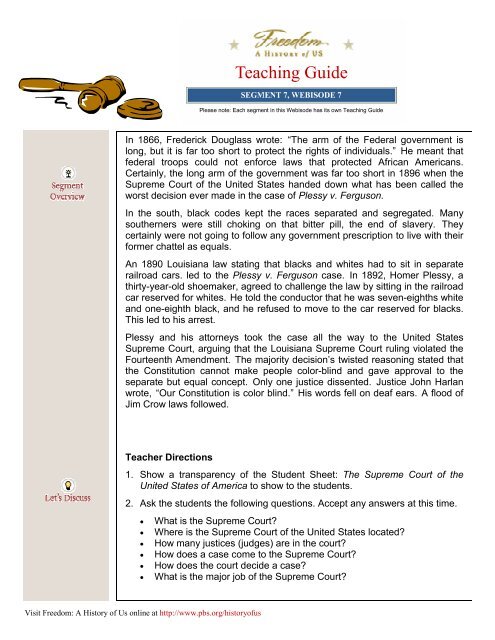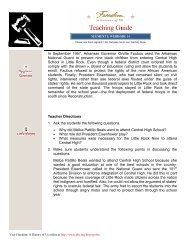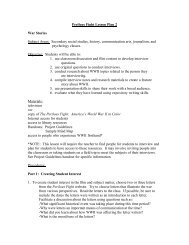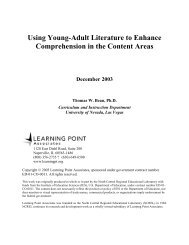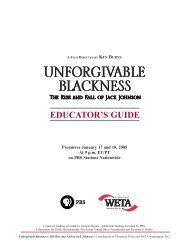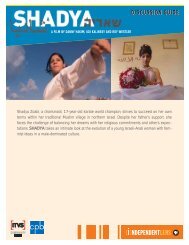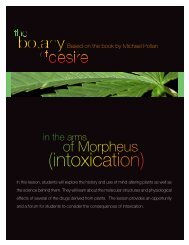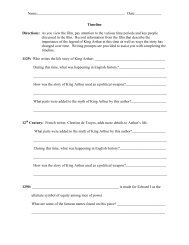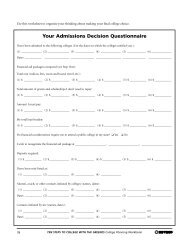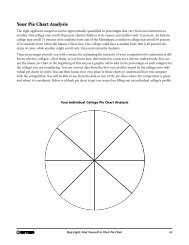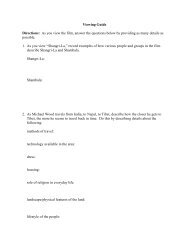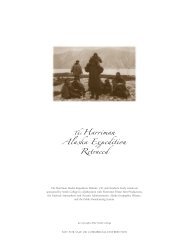Plessy v. Ferguson - PBS
Plessy v. Ferguson - PBS
Plessy v. Ferguson - PBS
You also want an ePaper? Increase the reach of your titles
YUMPU automatically turns print PDFs into web optimized ePapers that Google loves.
Please note: Each segment in this Webisode has its own Teaching Guide<br />
In 1866, Frederick Douglass wrote: “The arm of the Federal government is<br />
long, but it is far too short to protect the rights of individuals.” He meant that<br />
federal troops could not enforce laws that protected African Americans.<br />
Certainly, the long arm of the government was far too short in 1896 when the<br />
Supreme Court of the United States handed down what has been called the<br />
worst decision ever made in the case of <strong>Plessy</strong> v. <strong>Ferguson</strong>.<br />
In the south, black codes kept the races separated and segregated. Many<br />
southerners were still choking on that bitter pill, the end of slavery. They<br />
certainly were not going to follow any government prescription to live with their<br />
former chattel as equals.<br />
An 1890 Louisiana law stating that blacks and whites had to sit in separate<br />
railroad cars. led to the <strong>Plessy</strong> v. <strong>Ferguson</strong> case. In 1892, Homer <strong>Plessy</strong>, a<br />
thirty-year-old shoemaker, agreed to challenge the law by sitting in the railroad<br />
car reserved for whites. He told the conductor that he was seven-eighths white<br />
and one-eighth black, and he refused to move to the car reserved for blacks.<br />
This led to his arrest.<br />
<strong>Plessy</strong> and his attorneys took the case all the way to the United States<br />
Supreme Court, arguing that the Louisiana Supreme Court ruling violated the<br />
Fourteenth Amendment. The majority decision’s twisted reasoning stated that<br />
the Constitution cannot make people color-blind and gave approval to the<br />
separate but equal concept. Only one justice dissented. Justice John Harlan<br />
wrote, “Our Constitution is color blind.” His words fell on deaf ears. A flood of<br />
Jim Crow laws followed.<br />
Teacher Directions<br />
1. Show a transparency of the Student Sheet: The Supreme Court of the<br />
United States of America to show to the students.<br />
2. Ask the students the following questions. Accept any answers at this time.<br />
• What is the Supreme Court?<br />
• Where is the Supreme Court of the United States located?<br />
• How many justices (judges) are in the court?<br />
• How does a case come to the Supreme Court?<br />
• How does the court decide a case?<br />
• What is the major job of the Supreme Court?<br />
Visit Freedom: A History of Us online at http://www.pbs.org/historyofus
Page 2 of 4<br />
Segment 7, Webisode 7<br />
Let’s Discuss, Cont.<br />
3. Distribute one Student Sheet: The Supreme Court of the United States and<br />
one Student Sheet: What We Learned About the Supreme Court to each<br />
team. The team members take turns reading the information about the<br />
Supreme Court to their team. Team members take turns recording their<br />
team’s answers on the Student Sheet: What We Learned About the<br />
Supreme Court.<br />
4. Teams compare their answers in a class discussion. Make sure students<br />
understand the following points in discussing the questions.<br />
The Supreme Court is the highest court in the land. No other court can<br />
overturn a ruling made by the Supreme Court. The Supreme Court is<br />
located in Washington, D.C. Nine judges called justices serve on the court.<br />
One is the chief justice and the remaining eight are associate justices.<br />
Many cases come to the Supreme Court after hearings in lower courts. The<br />
court chooses to hear about 100 of the most important cases from about<br />
7000 cases every year. The Supreme Court also hears disputes between<br />
states. The court decides a case by vote. The majority ruling (the way most<br />
justices vote) becomes the court’s decision. Any justices who vote the<br />
other way are in dissent. That means, they do not agree with the majority.<br />
Both the majority and the dissenting side write out their opinions to explain<br />
why they voted as they did. The major job of the Supreme Court is to<br />
interpret and defend the Constitution.<br />
Teacher Directions<br />
1. The students imagine they are justices on the Supreme Court and will hear<br />
a very important case that the real court heard in 1896. Distribute the<br />
Student Sheets: Homer <strong>Plessy</strong> Breaks the Law.<br />
2. To open the court session, ask a volunteer to read the words that the<br />
marshal uses (from the Student Sheet: The Supreme Court of the United<br />
States). (Oyez means “attention!” and is pronounced “oh yes,” with the<br />
accent on the oh.) Justices shake hands with the other justices in their<br />
teams. Read about Homer <strong>Plessy</strong>’s case as the students follow along. Stop<br />
to discuss the information to be sure that students understand the actions<br />
of <strong>Plessy</strong> and the courts and the issues involved.<br />
3. Make a transparency of the Student Sheet: Is the Constitution Color Blind?<br />
Use a sheet of paper to block the majority and dissenting opinions, so that<br />
the students can read only the Fourteenth Amendment.<br />
4. Students, working in their small teams, imagine that they are justices on the<br />
Supreme Court. Remind the students that as Supreme Court justices, their<br />
most important duty is to interpret and defend the Constitution. Students<br />
review the facts of Homer <strong>Plessy</strong>’s case and the Fourteenth Amendment<br />
and discuss whether they think <strong>Plessy</strong> is guilty of violating the law or<br />
whether the Constitution protects his right to sit in any public railroad car.<br />
Visit Freedom: A History of Us online at http://www.pbs.org/historyofus
Page 3 of 4<br />
Segment 7, Webisode 7<br />
History Sleuth, Cont.<br />
Tell the students that they do not need to reach an agreement; the justices<br />
on the Supreme Court did not in this case.<br />
5. Each student individually writes his/her vote on the second page of the<br />
Student Sheet and a brief opinion to explain his/her vote.<br />
6. On the transparency, reveal and explain to the class how the Supreme<br />
Court justices voted. Ask the students to signal by raising hands who<br />
agreed with the majority opinion. Call on some volunteers to read their<br />
opinions. Repeat with students who agreed with the dissenting justice.<br />
Teacher Directions<br />
1. Expalin that the Supreme Court’s decision in the <strong>Plessy</strong> case allowed laws<br />
denying African Americans their civil rights to increase in the south. Ask the<br />
students.<br />
• What do you think motivated Homer <strong>Plessy</strong> to do what he did when he<br />
could have let the conductor think that he was white?<br />
• What would you have done in the same circumstances?<br />
• If you were a friend of Homer <strong>Plessy</strong>, what advice would you have given<br />
him before he got on the train?<br />
2. Students create a dialog about the train ride and what happened, and role<br />
play the parts of Homer <strong>Plessy</strong> and his friends.<br />
Teacher Directions<br />
1. Distribute the Student Sheet: Rosa Parks Takes A Seat. Working with a<br />
partner, students reread the Student Sheet: Homer <strong>Plessy</strong> Breaks the Law<br />
and read the Student Sheet: Rosa Parks Takes A Seat to compare the two<br />
cases.<br />
2. On the chalkboard or chart paper, draw a long vertical line to form two<br />
columns with the headings Similarities and Differences. Students list as<br />
many differences and similarities in Homer <strong>Plessy</strong>’s and Rosa Park’s<br />
situations as they can. Possibilities include the following.<br />
Differences<br />
• Different centuries (1896, 1955)<br />
• Homer <strong>Plessy</strong>’s case went to the Supreme Court.<br />
• Rosa Parks’ case sparked a civil rights movement that changed unfair<br />
laws.<br />
• Homer <strong>Plessy</strong>’s case allowed the passage of more unfair laws.<br />
Visit Freedom: A History of Us online at http://www.pbs.org/historyofus
Page 4 of 4<br />
Segment 7, Webisode 7<br />
Moving Toward Freedom,<br />
Continued.<br />
Similarities<br />
Both challenged unfair laws on purpose<br />
Both rode public transportation<br />
Both were in the south<br />
Both were arrested<br />
Both received fines<br />
Both were just working people, not activists or politicians<br />
Both are remembered for their courage<br />
Both Homer <strong>Plessy</strong> and Rosa Parks moved the country toward freedom.<br />
3. Be sure that the students discuss and understand how <strong>Plessy</strong> and Parks<br />
with their courage to defy unfair laws moved the country toward freedom.<br />
Teacher Directions<br />
Use the following activities with your students.<br />
Art — Students view the transparency of the Supreme Court building and<br />
create a sketch of the court, using or charcoal, crayon, pencil, or some other<br />
medium. Frame and display the drawings under the motto of the court: “Equal<br />
Justice Under Law.”<br />
Language Arts — Students write a poem entitled “An Ode to Homer <strong>Plessy</strong>.”<br />
Provide some examples of odes and help students understand that an ode is a<br />
poem praising someone.<br />
Visit Freedom: A History of Us online at http://www.pbs.org/historyofus
The Supreme Court of the United States<br />
Address: One First Street, NE, Washington, DC 20543<br />
Chief Justice:<br />
William H. Rehnquist<br />
Associate Justices: John Paul Stevens David H. Souter<br />
Sandra Day O’Connor Clarence Thomas<br />
Antonin Scalia<br />
Ruth Bader Ginsburg<br />
Anthony M. Kennedy Stephen G. Breyer<br />
Origin: The Constitution (Article III) created the Supreme Court of the<br />
United States. It was organized on February 2, 1790.<br />
The Term: The Court session begins on the first Monday of October and<br />
usually continues into June or July. The Court receives about 7000 requests<br />
for cases to be heard, from which it chooses about one hundred. It hears<br />
only the most important cases relating to the Constitution. Many cases<br />
come to the Supreme Court after trials in lower courts. The Court also hears<br />
disputes between states.<br />
The Purpose: “Equal Justice Under Law” is written above the main entrance<br />
to the Supreme Court Building. These words state the Supreme Court’s<br />
purpose. It must guard and interpret the Constitution, and it must protect<br />
human rights. No other court can overturn a ruling of the Supreme Court.<br />
That is why it is known as the highest court in the land.<br />
The Procedure: The justices, wearing black robes, shake hands with one<br />
another before they hear a case. Attorneys for each side have only thirty<br />
minutes to present their cases That’s not very long to make an argument!<br />
The justices hear the arguments and vote on the decision. The majority<br />
rules, but both the majority and the dissenting justices (those who<br />
disagree with the majority) write opinions.<br />
The Court’s marshal opens each session with the following words:<br />
The Honorable, the Chief Justice and the Associate Justices of the<br />
Supreme Court of the United States. Oyez! Oyez! Oyez! All person<br />
having business before the Honorable, the Supreme Court of the United<br />
States, are admonished to draw near and give their attention, for the<br />
Court is now sitting. God save the United States and this Honorable<br />
Court.<br />
Webisode 7 Student Sheet<br />
Segment 7, Page 1 of 6<br />
© The Johns Hopkins University. All Rights Reserved.<br />
For more information, visit Freedom: A History of US<br />
Online at http://www.pbs.org/historyofus
What We Learned About the Supreme Court<br />
Directions:<br />
Using your student sheet about the Supreme Court as a guide,<br />
discuss the following questions with your teammates. Take<br />
turns writing the answers to the questions.<br />
1. Where is the Supreme Court located?________________________________<br />
2. What words are written over the main entrance?<br />
__________________________________________________________________________<br />
3. Counting the Chief Justice, how many justices serve on the Supreme<br />
Court?<br />
__________________________________________________________________________<br />
4. How many women are on the Supreme Court?<br />
__________________________________________________________________________<br />
5. When was the Supreme Court organized (date)?<br />
__________________________________________________________________________<br />
6. How many requests to hear cases does the Court get per term?<br />
__________________________________________________________________________<br />
7. How many cases does it hear?<br />
__________________________________________________________________________<br />
8. How does the Court decide which cases it will hear?<br />
__________________________________________________________________________<br />
9. How long does term last?<br />
__________________________________________________________________________<br />
10. How do the justices decide a case?<br />
__________________________________________________________________________<br />
11. What is the majority opinion?<br />
__________________________________________________________________________<br />
12. What is the dissenting opinion?<br />
__________________________________________________________________________<br />
13. If someone does not like a decision of the Supreme Court, can he/she<br />
take the case to another court? _____________________________________<br />
Explain your answer.<br />
__________________________________________________________________________<br />
14. What is the major role of the Supreme Court?<br />
__________________________________________________________________________<br />
__________________________________________________________________________<br />
Webisode 7 Student Sheet<br />
Segment 7, Page 2 of 6<br />
© The Johns Hopkins University. All Rights Reserved.<br />
For more information, visit Freedom: A History of US<br />
Online at http://www.pbs.org/historyofus
The Supreme Court<br />
of the<br />
United States of America<br />
Webisode 7 Student Sheet<br />
Segment 7, Page 3 of 6<br />
© The Johns Hopkins University. All Rights Reserved.<br />
For more information, visit Freedom: A History of US<br />
Online at http://www.pbs.org/historyofus
Homer<br />
<strong>Plessy</strong><br />
Breaks<br />
The Law<br />
Homer <strong>Plessy</strong> was a shoemaker by trade. He was a law-abiding<br />
citizen. But like others, he thought black codes were illegal and<br />
offensive. He opposed the Separate Car Act that the state of Louisiana<br />
had recently passed, separating blacks and whites in railroad cars.<br />
Homer <strong>Plessy</strong> looked like a white man. He was only one-eighth<br />
black. In 1892, after discussing the unfair law with friends, they had an<br />
idea. <strong>Plessy</strong> and his friends wanted to show how unfairly blacks were<br />
treated. What if <strong>Plessy</strong> boarded a train and purposely sat in the white<br />
section?<br />
That is exactly what <strong>Plessy</strong> did! He took a seat in the white<br />
section of an East Louisiana railroad car. As expected, when the<br />
conductor found out that he was one-eighth black, <strong>Plessy</strong> was arrested.<br />
The fine was either $25 or 20-days in jail. He went to jail. His lawyer<br />
bailed him out for $500. They began to appeal the case. They said that<br />
the Separate Car Act violated the Thirteenth and Fourteenth<br />
Amendments.<br />
At his first trial, Judge John Howard <strong>Ferguson</strong> ruled that Louisiana<br />
had a right to pass the Separate Car law, and <strong>Plessy</strong> was guilty of<br />
breaking it. The Supreme Court of Louisiana also found <strong>Plessy</strong> guilty,<br />
and so did the Supreme Court of the United States. The Supreme Court<br />
said that it could not change the color of the races, so it could not<br />
abolish distinctions based on color, nor could it force people to comingle.<br />
Only one justice dissented. Justice John Harlan said “Our<br />
Constitution is color-blind, and neither knows nor tolerates classes<br />
among citizens. In respect of civil rights, all citizens are equal before<br />
the law.”<br />
Webisode 7 Student Sheet<br />
Segment 7, Page 4 of 6<br />
For more information, visit Freedom: A History of US<br />
Online at http://www.pbs.org/historyofus
Is the Constitution Color Blind?<br />
<strong>Plessy</strong> v. <strong>Ferguson</strong><br />
The Fourteenth Amendment<br />
All persons born or naturalized in the United States, and subject to the<br />
jurisdiction thereof, are citizens of the United States and of the State<br />
wherein they reside. No State shall make or enforce any law which shall<br />
abridge the privileges or immunities of citizens of the United States; nor<br />
shall any State deprive any person of life, liberty, or property, without<br />
due process of law; nor deny to any person within its jurisdiction the<br />
equal protection of the laws.<br />
The Majority Opinion<br />
The object of the Fourteenth Amendment...could not have been intended<br />
to abolish distinctions based on color, or to enforce socializing …or a<br />
co-mingling of the two races…<br />
Justice Henry Brown<br />
The Dissenting Opinion<br />
Our Constitution is color blind, and neither knows nor tolerates classes<br />
among citizens. In respect of civil rights, all citizens are equal before<br />
the law...In my opinion, the judgment this day...will, in time, prove to be<br />
quite as pernicious as the decision made by this tribunal in the Dred<br />
Scott case...The present decision may well…stimulate aggressions.<br />
Justice John Harlan<br />
Webisode 7 Student Sheet<br />
Segment 7, Page 5 of 6<br />
© The Johns Hopkins University. All Rights Reserved.<br />
For more information, visit Freedom: A History of US<br />
Online at http://www.pbs.org/historyofus
Rosa Parks<br />
Takes A Seat<br />
Here are Rosa Park’s own words:<br />
I was arrested on December 1, 1955, for refusing<br />
to stand up on the order of the bus driver, after the<br />
white seats had been occupied in the front. And of<br />
course I was not in the front of the bus. Many people<br />
have written that I got on the bus and took the front<br />
seat, but I did not. I took a seat that was in back of<br />
where the white people were sitting, in fact, the last<br />
seat. When the driver noticed [a white man standing],<br />
he told us [all] to let him have our seats….when the<br />
other three stood up...he wanted to know if I was going<br />
to stand up, and I was not. And he told me that he<br />
would have me arrested. And I told him you may do<br />
that. And, of course, he did.<br />
Rosa Parks was a seamstress. At her trial on December 5,<br />
1955, she was found guilty of not giving up her seat. Her fine<br />
was $10 plus $4 in court costs. Members of the black community<br />
were so angry that they organized a bus boycott on the day of<br />
her trial.<br />
When asked why she kept her seat, Ms. Parks replied that<br />
while she felt no anger, “I did feel determined to take this as an<br />
opportunity to let it be known that I did not want to be treated in<br />
that manner and that people [had] endured it too long.”<br />
Webisode 7 Student Sheet<br />
Segment 7, Page 6 of 6<br />
© The Johns Hopkins University. All Rights Reserved.<br />
For more information, visit Freedom: A History of US<br />
Online at http://www.pbs.org/historyofus


